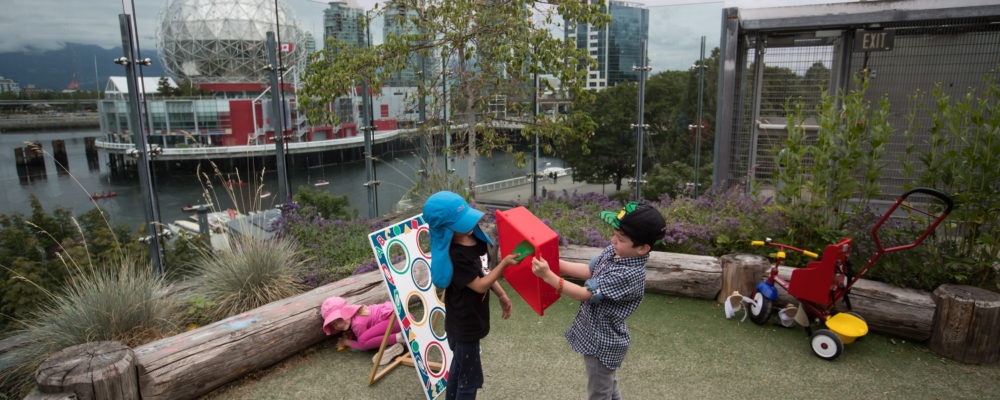If you cannot name or describe something, you cannot see it. And if you can’t see something, you are apt to destroy it. This is exactly what is happening with our child care debates in Canada.
Our failure to see, understand, and describe the dynamics of child care in Canada is leading us to pursue policies that have more in common with industrialists and capitalists than those who care about nurturing the next generation of Canadians. And, like clear cutting, and other technocratic approaches to life, it will leave us worse off as a country.
In his wonderful book Landmarks, the British author and conservationist, Robert MacFarlane tells a story about flying over the environmentally sensitive Brindled Moor located in Lewis, an island in the Outer Hebrides of Scotland. As they’re flying, his seatmate — an industrialist who wants to turn the island into a power generating station — looks over the landscape and declares it a wasteland; “there’s nothing there.” Yet, as Macfarlane notes, “the moor is one of the world’s last great peat-bogs, whose ecological significance has been compared to that of the Serengeti…its biodiversity and appearance make it the centrepiece of the Hebrides’ £60m-a-year tourism industry. The moor, in its strange, wild beauty, is also at the core of Lewis’s embattled Gaelic self-identity.”
MORE SIGNAL. LESS NOISE. THE HUB NEWSLETTER.
Now compare this to the way universal child care advocates talk about the landscape of care in our country. Public advocates for universal care decry the lack of capacity of child care in Canada, and declare the highly diverse social landscapes of places like working class Brampton, Kitchener, and, well, most of Canada as “child care deserts.”
These advocates are like the myopic industrialist who looks over a landscape that is so diverse and complex that locals compiled a “peat glossary” to help scientists describe the varied types of earth, and declares it a wasteland. There are all kids of examples of “modern practices” laying waste to rich ecosystems. Take, for instance, the way forestry managers almost destroyed the rare Oak Savanna at Ontario’s Pinery Provincial Park. They “viewed the open nature of this ecosystem as degraded,” and attempted to plant commercial pines in one of the rarest forest environments in Canada. Both the foresters of the 60s and those pushing Canada’s child care policy into a direction that prefers homogeneity are guilty of committing the “American-Puritan error” which equates “wild land with wasteland.” It’s no coincidence that both mentalities are rooted in the high-modernist era of the 60s and 70s.
The rich, multigenerational homes in which grandparents, and other family members that provide care — and that are far more common in immigrant and indigenous communities — are described as arid and not worthy of notice. These advocates can only see daycare spaces licenced and regulated by the state as worthy of attention, and government support. Should we be surprised that a place with such a high number of immigrants and diverse families such as Brampton are described as deserts, while the rich suburbs of Oakville are declared an oasis? Because the advocates deem licensed care as quality, child care in Oakville is declared quality. For the same reason, child care in Brampton is declared to be of poor quality, like cheap, imported goods. Where have we seen this before?
One of the core reasons underlying this narrow focus on licenced care is a faulty understanding of the asymmetry of information on quality being a core market failure in child care. This is a common point, and one that appears even in otherwise sensible policy research.
What does this mean?
The core of this concern is that parents can’t be certain about the quality of child care. Children can’t or don’t evaluate their providers care in the same way as parents, and can’t or don’t communicate concerns with quality of child care because, well, they’re kids. They’re not capable of the complex judgments that parents are. In a child care setting, parents send the kids in and head off to work. They really don’t know what’s going on because they’re absent and unable to observe it.
Stop undervaluing the possibilities of organic relationships and communities in the world of public policy.
And when they pick the kids up at the end of the day, the kids can’t really give a quality or reliable report on the quality of care. The best you’ll get is something like this:
Parent: “how was your day?”
Kid: “good” (or) “okay” (or) “mumble mumble” (or, most likely) “I’m hungry, what’s for supper?”
And that assumes they can talk. Infants can’t even give that much of a report.
Even if the child does give a better report the parent cannot really tell whether it’s trustworthy or not. That’s the asymmetry. There is some level of “quality” of care, but the parent, because they’re not there to observe, doesn’t have the data on which to make a judgment about quality, and can never really know. That’s the market problem.
The solution to this problem for proponents of licenced care is to introduce a signal that acts as a type of seal of quality, sort of like “Grade A chicken” is a seal that shows that you’re getting quality. The preferred signal for daycare advocates is a common regulatory signal: a license.
The license is supposed to indicate a base (or higher) level of quality that stands in for the information the parent lacks. Now, on the one hand, this isn’t bad per se. We can articulate standards and send signals to show they have been met, and a certain level of regulation (for instance, the requirement of police checks is a classic example of a good requirement) makes total sense.
But the assumptions that align “licenced” with “quality,” or the presumption that licences will solve the market problem of asymmetrical information — and particularly the way it’s used to place all government financial support toward regulated care as the federal budget does — is faulty. It doesn’t align with real life and can lead to potentially perverse outcomes.
Here are the key issues with the assumptions behind the asymmetry of information market failure.
The first is that it assumes a technocratic understanding of quality. That is, that child care (a complicated matter if there ever was one) can be given a rubric of indicators of quality from civil servants that will stand in for a genuine marker of the love and care that a child receives or not. Again, basic standards can make sense (staff-to-child ratios and background checks are a few good examples) but these standards all lean toward the legible and easily quantifiable.
As quality markers, the qualitative insight from a lot of these standards are very hard to find or highly debatable. Take, for instance, another preferred measure: an Early Childhood Educator certification of some sort. It’s plausible that ECEs can provide higher quality of care than say, your neighbour, or someone from your mosque, or temple, or your family (or anyone with whom you have an organic connection) but on what grounds? Often, again, it comes back to some sort of quantifiable measure.
The state is good at putting in measures, but how does this change the conversation between the parent and the child on the way home from daycare?
Moreover, and this is perhaps my biggest problem with the conflation of licenses and quality, it dramatically underappreciates the extent to which parents garner qualitative information organically and communally.
Think about how people go about finding a child care provider. You might go online to seek a licensed or government spot and say “done.” But that’s not what most parents do. Most parents ask their friends, neighbours, parents, and other members of their community for feedback. This organic grazing for information and gleaning of insight from people you trust and relate to is part and parcel of how parents evaluate quality. That’s why positive word of mouth feedback is the holy grail for any institution, because it’s the most reliable and trustworthy.
Another problem with this conception of a market failure is that it assumes that the parent/child communication feedback loop is functionally unreliable. Granted, children aren’t fully reliable, but parents are far more in-tune with the effects of care on their kids than this suggests.
On a given day a child doesn’t provide a clear binary good/bad signal about quality, but over time, patterns show up. You notice things. The author’s four children have been in the full range of care settings (from at home with mom or dad, to extended family, to neighbours, to friends, to unlicensed day homes to licenced institutional care), and in each case we had a pretty good read of the effect of each setting on the kids. We used a variety of things — conversations with other parents, providers, conversations with kids, our own intuitions — to evaluate the quality of care our children received. Was it perfect? No. But there is no signal that is. Assuming that licenses will provide certainty on quality, or even radically re-balance the symmetry of information is misguided. It’s one signal, but probably not even the best one.
This isn’t an argument against regulations of any sort, it’s a critique of using technocratic biases to shape daycare policy, and an argument against basing an entire system upon one feedback measure that is one among many.
More importantly, it’s a call for us to stop undervaluing the possibilities of organic relationships and communities in the world of public policy. The desire to make the complex, organic world of child-care and family/work life into something legible is an inherently corporatist project.
Note that this isn’t a call for libertarianism or even fiscal conservatism with regard to child care. As we note in a recent paper, “particularly for parents in low-wage occupations, child care may consume the majority of the income gained from employment, leading to a rational decision to forgo work outside the home. It is understandable, therefore, that governments consider policies to alleviate the financial burden of child care and boost labour-force participation.”
The state has a role to play, and an approach to policy that respects the ecosystem of care in Canada might end up spending more than the (wrong) estimates of the universal program. It’s not about the money, but the role. And the state’s role should be focused on enabling parents to make decisions that work best for them and their families, and on encouraging other parts of society (especially business, which seems to have gotten a free ride) to support families.
This article begins by noting that if you don’t have the language to describe something, you can’t see it. And if you can’t see it, you’ll end up destroying it. This is precisely what’s happening with our child care discussions. How to preserve the rich ecosystem of care in the face of the strong technocratic, corporatist tides that seem so strong?
Here it’s worth returning to MacFarlane. He says “those who wish to explain to politicians and others why landscape should be nurtured… face a daunting task where the necessary concepts and vocabulary are not to hand. What is required is a new nomenclature of landscape and how we relate to it.”
Canadian child care policy needs a new nomenclature and it should start with a definition of quality that is in line with the everyday practices of Canadians, and a definition of support that encourages and enables everyday Canadians to live the lives they deem best for their families.




